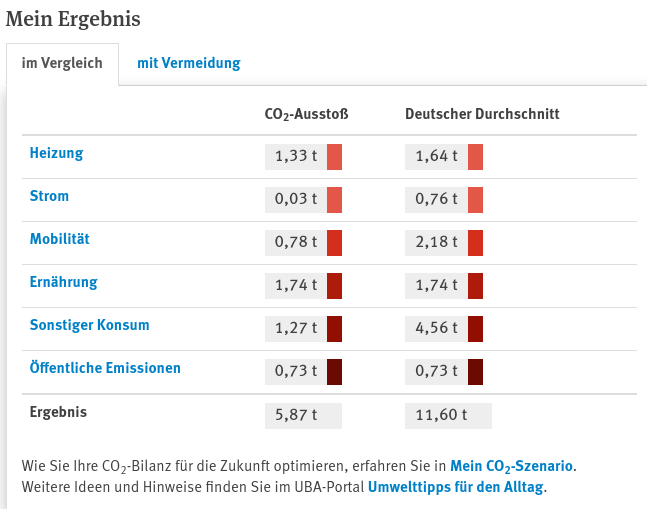This post collects some attempts of mine to monitor my carbon footprint.
Individual products
Assigning a carbon footprint to an individual product is extremely hard, especially from a customer’s persprective. I talked about my struggle of buying nuts in an earlier blogpost (in German). A CO2 tax would serve as an indirect indicator via the price, but of course there is no one-to-one correspondence. I would advocate for a carbon label similar to the kcal indicator on food products. I appreciate that this is a challenging endeavor. Nonetheless, to me it seems to be a promising way to make informed decisions and to bring forward a culture of transparency and awareness.
Overall lifestyle
Let us go one abstraction layer higher and check our overall lifestyles. Uncertainties will get larger but we might get an idea of where the largest reduction potentials lie. There exist several carbon footprint calculators on the web (or apps for your phone) which guide you through your personal CO2 confession. I used the “CO2-Rechner” by the German Umweltbundesamt, as well as the app “Klimakompass” . Since April 22, 2020, Klimakompass is using an evaluation scheme provided by the startup Worldwatchers , which is collaborating with experts from Wuppertal Institute .
Results

Fig. 1: Personal CO2 footprint (tons per year CO2 equivalent) computed with “CO2-Rechner” from Umweltbundesamt.

Fig. 2: Personal CO2 footprint (tons per year CO2 equivalent) computed with the app “Klimakompass” .
This does not look bad if compared to the average household in Germany. However, it is still around double of what each of us may blow into the atmosphere if we want to reach the 2°C goal.
The largest discrepancies between the two different methods (Fig. 1,2) lie in the emissions associated with heating and consumption. Heating: This was estimated by the CO2 calculators since I did not have the records at hand; they probably use different estimates. This will be fixed as soon as I have the exact data. Also, each tool asks for slightly different data, e.g. hours of streaming for Klimakompass. In general, “CO2-Rechner” incorporates more details.
How did I arrive at the (compararatively small) numbers above in the first place?
- I live in a flatshare, so I do not occupy, i.e. heat (with gas), a huge space just for myself (“Heizung”).
- We consume green electricity (“Strom”).
- I do not own a car but use the train quite a bit (~15.000km/yr, “Mobilität”).
- I eat mostly vegetarian (“Ernährung”).
- I do not consume much which is not food (~150€/month, “Sonstiger Konsum”).
- I cannot do much about public emissions (“Öffentliche Emissionen”).
I think the largest uncertainty lies in the consumption. This is something I need to check more thoroughly1. So I might actually be up to 3t/yr worse, but let us stick to the slightly positive picture for now.
Conclusion
Some things I consider:
- become a real vegetarian (-0.3t/yr),
- travel a little less,
- monitor my consumption,
- ask my landlord about energy efficiency measures for our property.
A topic I did not touch upon are “investments”. Some of us are privileged and have some spare money, which they can invest into other things than personal consumption. Investments provide an additional lever for your personal impact on carbon emissions. I will keep this topic for another blogpost.
-
I think I will at least monitor my actual consumption for the month May 2020, maybe longer :). ↩︎